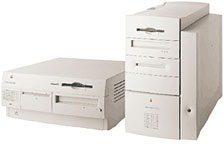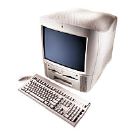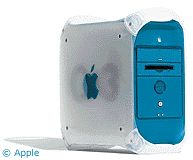Mac Musings
Older Macs in the Age of Leopard
The Future of G3 Power Macs in the Age of Leopard
Daniel Knight - 2007.09.12, updated
When I began Low End Mac ten years ago, there were no G3 Macs. When Apple introduced the first G3s, which were about 50% more efficient than earlier PowerPC 604e CPUs, everyone was excited.
When Apple releases Mac OS X 10.5 Leopard in October, there will be no support for G3 Macs.
The first G3 Macs, the PowerBook G3 and beige Power Mac G3, were introduced in November 1997. The 250 MHz PowerBook G3 was the world's most powerful notebook, and the 266 MHz Power Mac G3 held its own against the Power Mac 9600 with a 350 MHz 604e CPU.
The last G3 Macs, the 12" iBook and 14" iBook, were discontinued in October 2003. The fastest G3 Macs were those upgraded with a 1.1 GHz PowerForce upgrade (recently reintroduced at 1.0 GHz for US$140).
The best selling G3 Macs were the iMacs, which took the market by storm in 1998, going through two major versions and numerous revisions between the 233 MHz Bondi blue iMac of August 1998 and the 700 MHz iMac that was phased out in March 2003.
The question is: What does the future hold for G3 Macs?
Today we'll look at G3 Power Macs.
The Beige G3
Rolled out on November 15, 1997, the first generation Power Mac G3 put a 233 MHz or 266 MHz G3 processor in either a minitower or a full-sized desktop enclosure. Because the G3 was so much more powerful per MHz, it replaced Apple's vastly flexible, expandable Power Mac 7300, 8600, and 9600, although the 9600 remained in the line for several more months for those who needed dual processors or more than three PCI slots.
 There
were two different motherboards and three different ROM versions used
by the first generation beige G3. Rev. 1 motherboards and Rev. A ROMs
don't properly support slave drives under the Classic Mac OS. Rev. 2
motherboards, which came with Rev. B or C ROMs, don't have this
problem.
There
were two different motherboards and three different ROM versions used
by the first generation beige G3. Rev. 1 motherboards and Rev. A ROMs
don't properly support slave drives under the Classic Mac OS. Rev. 2
motherboards, which came with Rev. B or C ROMs, don't have this
problem.
 There was a
Power Mac G3 All-in-One
that included a 15" multiscan display. It's an odd looking beast,
earning the nickname "molar" by many who have seen it. It's big and
heavy, but it has the same expandability as the modular models.
There was a
Power Mac G3 All-in-One
that included a 15" multiscan display. It's an odd looking beast,
earning the nickname "molar" by many who have seen it. It's big and
heavy, but it has the same expandability as the modular models.
Apple introduced a revised beige G3 with a 300 MHz CPU in March 1998, followed by relatively rare 333 MHz and 366 models in August. Being a newer model, there was no issue with slave drives. (That said, if you're buying a used G3/333 or 366, be aware that it might be a Rev. 1 model with a CPU upgrade.)
Not being a thoroughly modern design, it suffers from the same 8 GB restriction as the WallStreet PowerBooks and Rev. A-D iMacs. That is, if you want to run Mac OS X on a beige G3, if it's installed on the internal IDE bus, it must be on the hard drive's first partition, and that partition must be under 8 GB in size.
The best feature of the beige G3 is the ZIF socket that holds the CPU. It's very easy to remove the G3 processor and plug in a faster G3 or even a G4. It takes some adjustments to the J16 jumper bank to change support for faster CPUs by adjusting the system's bus speed and the CPU multiplier, but it's not hard to do.
The beige G3 has an EIDE drive bus that supports 16.67 MBps throughput and drives up to 128 GB in size - fast and large for 1997, but restrictive by today's standards. There's room for two internal hard drives, one optical drive, a floppy (the last Power Mac with one), and one additional device such as a Zip drive or DAT drive.
The beige G3 supports up to 768 MB of memory. Be sure to buy 256 MB modules compatible with the beige G3 - the must be built using 128 Mb chips or the computer will only recognize 128 MB of RAM.
Probably the biggest drawback this model has is the ATI 3D Rage II+ (found on Rev. 1 boards) and Rage Pro graphics processors that came with 2 MB of video RAM and can only be expanded to 6 MB. Although fine for the Classic Mac OS, this is severely underpowered for OS X.
To address this, you can buy a PCI video card that supports Macs. The ATI Rage 128 card with 16 MB of video memory from the Blue & White Power Mac G3 is a popular choice. Newer, more costly alternatives include the ATI Radeon 7000 and 9000 PCI Mac Edition with 64 MB VRAM and the 9200 PCI Mac Edition with 128 MB. Another option is the ixMicro Ultimate Rez PCI video card that was used in the 9600 and some Macintosh clones.
Beige G3s can run anything from Mac OS 8 through OS X 10.2.x officially - and 10.3 and 10.4 using XpostFacto. Mac OS 8.1, 8.6, and 9.2.2 would be our choices for the Classic Mac OS, and we'd probably go no higher than 10.3 with OS X.
Beige G3s tend to sell cheaply these days. We've seen them for under $50 because of their severe limitations under OS X and the amount of upgrading necessary to make them decent OS X machines. Besides maxing out RAM (about $55) and adding a video card, you could also look into an UltraATA controller card to break the 8 GB barrier and give you a lot more hard drive speed. Then add a 7200 rpm drive, and you've invested a whole lot in a very old computer.
Because OS X is very dependent on a powerful graphics processor (moreso with each revision), we can't recommend going past OS X 10.2 without adding a better video card. Even then, the PCI bus itself is a bottleneck - something Apple would address in the next G3 Power Mac. Unless you already have a maxed out system, we can't recommend even trying Tiger - 10.3 "Panther" is about as far as you'd want to take it.
Looking a head to Leopard, we'd say don't even think about it with the beige G3.
Further Reading
- OS X and the Beige G3, 2001.12.21
- Upgrading an Old G3, 2002.03.15
- OS X on a Beige G3, 2002.03.25
- Speeding Up a Beige G3, 2002.10.28
- The Value and Limitations of the Beige G3, 2003.03.03
- Making the Move from Jaguar (OS X 10.2) to Panther (10.3), 2006.04.11
- Guide to G3 ZIF Upgrades and Guide to G4 ZIF Upgrades
Blue & White G3
The second-generation G3 Power Mac brought a whole new look to Apple's pro line. Obviously inspired by the colorful iMac, the blue & white Power Mac G3 was finished in blueberry and frosted white. It was a completely new, modern design that included both USB and FireWire ports (however it cannot boot from FireWire and does not support Target Disk Mode). And in a nod to the past, it also includes an ADB port for older Apple mice, keyboards, and peripherals.
 The B&W G3 shipped in
300, 350, 400, and 450 MHz configurations, often came with a DVD-ROM
drive, and used the same ZIF socket for the CPU as the beige G3, making
CPU upgrades pretty easy. G3 upgrades to 1.1 GHz have been available
for it.
The B&W G3 shipped in
300, 350, 400, and 450 MHz configurations, often came with a DVD-ROM
drive, and used the same ZIF socket for the CPU as the beige G3, making
CPU upgrades pretty easy. G3 upgrades to 1.1 GHz have been available
for it.
The B&W has it all over the beige: The system bus is twice as fast (UltraATA), as is the hard drive controller - and the optical drive controller is even faster (UltraATA 66) . There are four PCI slots instead of three - one runs at 66 MHz for faster video, and the other three are 64-bit PCI slots at the traditional 33 MHz speed. With a Radeon PCI video card, you can even use Quartz Extreme, which Apple's doesn't support on PCI, with the PCI Extreme! hack.
One the negative side of the ledger, the B&W shipped with the same round "hockey puck" mouse and non-extended USB keyboard as the consumer iMac, and it had no internal floppy drive - the first pro Mac without one.
As with the beige G3, there were two different motherboard revisions, and the Rev. 1 B&W board can be problematic with OS X, and models with the Rev. 2 board shipped with a faster version of the ATI Rage 128 PCI video card. The Rev. 2 improves support for slave drives and addresses some drive corruption problems, so it's strongly recommended over Rev. 1.
The B&W G3 doesn't support drives over 128 GB on its main drive bus, but the UltraATA 66 bus used by the optical drives supports so-called Big Drives - and it's twice as fast.
Because the B&W G3 doesn't have an 8 GB partition issue, has twice as fast a system bus, has faster drive support, includes a double-speed PCI slot for video, supports up to 1 GB of memory, and has built-in USB and FireWire, we strongly recommend it over the beige G3.
We've heard very mixed reports about Tiger on the blue & white G3. Some people get it running with no trouble whatsoever, and others never get it to work. We can wholeheartedly recommend the B&W G3 as a fantastic Classic Mac OS machine and a very good OS X machine through 10.2. You should be able to get 10.3 running nicely, but we'd hesitate to recommend 10.4 due to the number of people we've heard of having problems with it. (For those who get it to work, it's wonderful.)
As far as OS X 10.5 goes, even if you have a G4 upgrade, we'd recommend against it. There's just no way you're going to be happy with video performance; even early AGP Macs are going to be stressed under Leopard. We have received a few reports of people attempting to run Leopard on an upgraded B&W G3 (see Unsupported Leopard Installation), but so far they all report failure.
Further Reading
- Why Apple's Blue & White G3 Is a Best Buy, 2003.03.04
- Migration Issues in Moving from a Beige G3 to a Blue and White, 2004.02.20
- Upgrading a Power Mac G3 from Mac OS 9 to Panther, 2004.12.03
- Mac OS X and the Blue and White G3 Firmware Update Problem, 2005.03.01
- Is That Old Power Mac G3 Still Useful in the Workplace?, 2006.01.10
- Guide to G3 ZIF Upgrades and Guide to G4 ZIF Upgrades